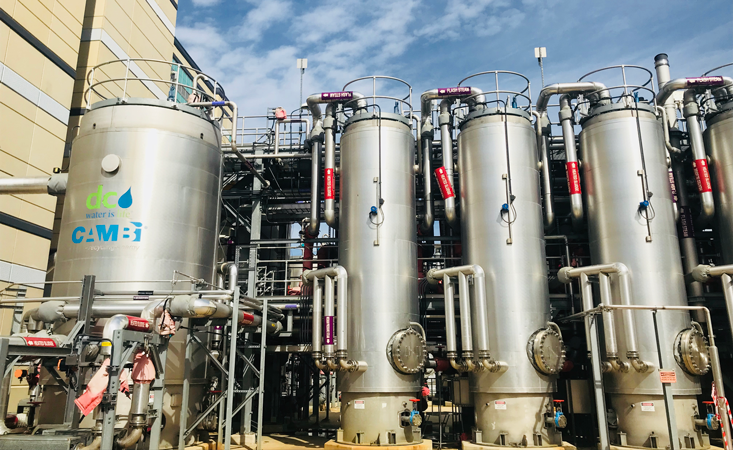I’m standing on an observation platform atop 24 colossal pressure cookers that belong to DC Water, the sewage treatment plant of our country’s capital. You may think that a sewage plant isn’t much to look at, but there’s a lot to take in from this observation platform. In front of me there are fields of silvery pipes stretching over massive sewage aeration tanks, where sludge percolates after it first arrives. To my left there’s a building that holds a dewatering centrifuge that turns this sludge into a goo ready for the next processing step—the pressure cookers that hum steadily below me as they simmer. They are slowly cooking shit into something awesome.
DC Water processes the contributions of about 2.2 million people who live, work, or visit the capital and the area that surrounds it. There’s input here from every residential house, every apartment building, every business and every historical landmark—Tyson’s Corner, the Smithsonian Institution, the Lincoln Memorial, and Capitol Hill. And the White House, of course. There’s some presidential poop percolating in those aerating tanks, along with the input from the Senate, the House of Representatives, the Pentagon, and the protestors chanting in front of the White House lawn. “That’s where all of us come together,” quips Bill Brower, a resource recovery engineer who is showing me around the plant. “And I’d like to thank all these people for their contributions.”
Despite the joke, Brower is quite serious. Unlike many other wastewater treatment plants, DC Water doesn’t identify as such. It describes itself in a different way: a resource recovery facility. There’s a reason for that, says Christopher Peot, the plant’s director of resource recovery, who is trying to change the mentality of the sanitation business. “There’s no such thing as waste, only wasted resources,” Peot says. “So we don’t process waste here. We recover resources.”

To an average toilet-flusher, resource recovery from poo may be a shocking concept. For one thing, sewage management is incredibly difficult, and happens on a large scale. An average adult produces about a pound of poop a day so the Washington area dishes out a pretty impressive pile. What do you do with all this crap? Especially when there’s no vast amount of farmland nearby? Many wastewater plants destroy or landfill it. Meanwhile, farmlands are getting depleted after growing crops for years, so farmers use synthetic fertilizer to boost production. Mother Nature’s link is clearly broken.
That’s exactly what DC Water is trying to fix. One of the most ecologically savvy sewage treatment facilities in the country, DC Water uses the so-called thermal hydrolysis or THP process, which renders sludge harmless and converts it into a safe form of fertilizer. As Brower walks me down from the observation deck to the tanks labeled Heated Sludge, he explains the inner workings of the pressure coolers to me. Originally designed in Norway and called Cambi, the system consists of a pre-heating tank, called a pulper, and a series of upright cylinder tanks, in which pumped sewage is heated to 300 degrees Fahrenheit and pressurized to six atmospheres for half an hour. “That’s six times more than what you are feeling now,” Brower says. “That’s how you kill all the pathogens.”
“We don’t process waste here. We recover resources.”
The stewed sludge is loaded into the so-called biodigesters—four humongous concrete tanks where a microbial menagerie chews through it, slowly breaking it down. “Digesters work just like our stomachs,” Brower explains. “They take big complex molecules like proteins, carbohydrates, and fats, and break them down into smaller and smaller bits. And just like bacteria in your stomach, bacteria in the digesters break down proteins into amino acids, which become food for the bacterial community further down the food chain, and so on.”
As the microbes feast on the sewage stew, they dramatically reduce the amount of “dark matter” that DC Water needs dealt with. Without the digesters, the plant would generate 1,100 tons of biosolids daily, which even in their pathogen-free form still need to be trucked somewhere, with the use of fossil fuels. The microbes reduce this amount to nearly one third. “We went from producing 1,100 tons a day to 450 tons a day,” Brower says. “The rest literally goes ‘puff,’ and not just puff but a puff that you can burn and create power,” he points out. The microbes produce methane, which burns to spin the plant’s electrical turbines, generating 10 megawatts of power. “Ten megawatts is enough to power about 8,000 homes in this area. And the remaining 450 tons becomes our premium product: Bloom. Let me show you how it happens.”
He hands me a hardhat with a blue and green DC Water Logo, puts on his own, and heads into a concrete building filled with conveyor belts. Officially called belt filter processors, they are designed to squeeze as much water out of the digested sludge as possible. They resemble giant moving cheesecloths stretched out flat, only instead of white squishy curds it’s draining black soggy ones. And as the cheesecloth carries these glops along, the water drips down through it so the soupy substance becomes less and less watery. It starts like a muddy stream and drains to a consistency of wet forest soil.
At the conveyor’s end, two roller presses flatten out this soil-like substance into shiny black sheets. The sheets quickly crumble into fragments resembling pieces of coal or graphite, only thinner and more uniform because they have been neatly pressed. The conveyor drops the fragments into a deep crater with an overhanging backhoe. It looks more like a coal-mining crater than a waste treatment plant and it makes me think of a quarry. And then it hits me. Of course it’s a quarry. DC Water is quite literally mining black gold.
“I like that name, Black Gold,” says Brower, chuckling at my description. But this isn’t yet the last step, he adds. A third-party company named Homestead Gardens takes this black gold, ages it, dries it up, and packages it into 25-pound bags labeled Bloom. “We can make a more marketable material if we age it,” Brower says, because the moist product sticks to your boots and shovels, but the dry one is powdery and light.
Brower finds an open bag and scoops up a handful of Bloom. He takes a sniff and offers me to do the same. I hold a little Bloom mound in my hands and examine it closely. The dry, crumbly substance resembles your everyday garden dirt. It neither looks like shit nor reeks of it. It smells of forests, meadows, riverbanks, fertile earth, and the promise of the next harvest.
“I grow everything with it, squashes tomatoes, eggplants,” I hear Brower say. “Everything grows great and tastes great,” he says. “And I’m not the only one who thinks so. We’ve heard from a lot of people that they’ve got the best response they’ve ever seen from the plants. Particularly with leafy greens because that nitrogen boost does well with leafy plants. And the plants seem to have fewer diseases and fewer pests around—probably because Bloom helps build healthy soils.”
Besides gardeners, Bloom has proven popular with landscape architects and construction companies that buy good soil for horticultural use. As they clear sites for new developments, they often strip off the topsoil, which later needs to be replaced. Bloom helps restore the damage done—and it doesn’t smell like manure, so tenants don’t complain.
On my way back from DC Water I hold my hand to my face and realize it still smells of Bloom’s pleasant springtime scent. I sit on the train sniffing my hands, oblivious to the curious glances of other passengers, wondering what else can we do with our dark matter, with that potent organic power within us? Can we turn it into other forms of black gold? And it turns out, we can. When recycled properly, poop can power your home, cook your food, fuel your car, and even stave off algae blooms and floods. We even have the technologies to do it, and some companies are doing it already. We just have to stop pretending that our shit doesn’t stink—and use it for what it’s worth.
Read author Lina Zeldovich’s 3 greatest revelations while writing The Other Dark Matter here.
Lina Zeldovich is an award-winning popular science writer and former Nautilus editor. She has written dozens of stories for major publications in the United States, Canada, and the United Kingdom, including the Smithsonian, Popular Science, and Scientific American, and won four awards for covering the science of poo. Her book, The Other Dark Matter: The Science and Business of Turning Waste into Wealth and Health, presents novel solutions to the world’s oldest problem—keeping humans free from their own excrement. @LinaZeldovich
Adapted from The Other Dark Matter: The Science and Business of Turning Waste into Wealth and Health by Lina Zeldovich, to be published by University of Chicago on Nov. 19, 2021. Copyright © 2021 by Lina Zeldovich.
Lead image: funnyangel / Shutterstock























